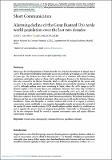Por favor, use este identificador para citar o enlazar a este item:
http://hdl.handle.net/10261/274620COMPARTIR / EXPORTAR:
 SHARE SHARE
 CORE
BASE CORE
BASE
|
|
| Visualizar otros formatos: MARC | Dublin Core | RDF | ORE | MODS | METS | DIDL | DATACITE | |

| Título: | Alarming decline of the Great Bustard Otis tarda world population over the last two decades |
Autor: | Alonso, Juan Carlos CSIC ORCID ; Campos Palacín, Pablo CSIC | Palabras clave: | Conservation Demography Endangered species Population estimate |
Fecha de publicación: | 13-jun-2022 | Editor: | Cambridge University Press | Citación: | Bird Conservation International 32(4): 523-530 (2022) | Resumen: | Since 2005, the world population of Great Bustards Otis tarda has decreased at an annual rate of 3.23%. The current world total is estimated at 31,000–36,000 birds, 34% (range 30–38%) less than 16 years ago. The declines have been observed in nine of 17 countries with extant breeding populations, with highest values in China (-89%) and European Russia (-72%). Marked decreases have also occurred in the Iberian Peninsula, which is still the stronghold for the species with 70–75% of the world population. Within Iberia, declines are particularly alarming in Portugal (-50%), although perhaps even more concerning in Spain, where the -28% (range 25–30%) decrease implies a loss of more than 8,000 individuals. Increases have been only recorded in Germany, Austria, and at a smaller scale in Hungary (respectively, 202%, 91%, and 5%), thanks to continued and intensive conservation actions, and also in the small group breeding in Romania, likely due to dispersal from the increasing West Pannonian population. The isolated populations of Morocco and Iran are on the brink of extinction. More surveys are still needed in Russia, Ukraine, Kazakhstan, China, and Mongolia, to confirm numbers and trends. It is urgent to reinforce conservation actions worldwide to stop negative demographic trends and ensure the survival of the species. If current trends continue, IUCN should perhaps consider whether (a) conditions are met to upgrade the species’ Red List category from globally ‘Vulnerable’ to ‘Endangered’, and (b) the two subspecies should be treated as separate conservation units and require different conservation strategies. | URI: | http://hdl.handle.net/10261/274620 | DOI: | 10.1017/S095927092200003X | ISSN: | 0959-2709 | E-ISSN: | 1474-0001 |
| Aparece en las colecciones: | (MNCN) Artículos |
Ficheros en este ítem:
| Fichero | Descripción | Tamaño | Formato | |
|---|---|---|---|---|
| Alonso_JC_Alarming.pdf | 133,01 kB | Adobe PDF |  Visualizar/Abrir |
CORE Recommender
SCOPUSTM
Citations
4
checked on 11-abr-2024
WEB OF SCIENCETM
Citations
2
checked on 29-feb-2024
Page view(s)
66
checked on 22-abr-2024
Download(s)
61
checked on 22-abr-2024
Google ScholarTM
Check
Altmetric
Altmetric
Este item está licenciado bajo una Licencia Creative Commons



